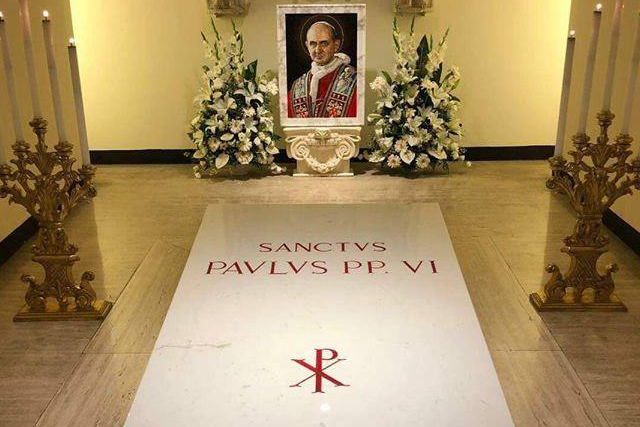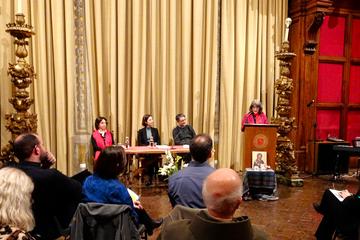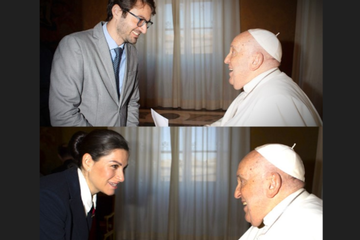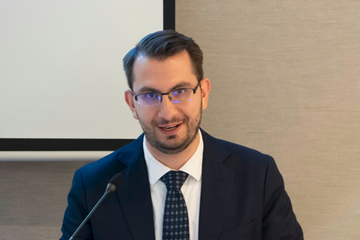
ROME— The Lay Centre has a special connection with the new saint, who Pope Francis hailed as “a prophet of a church turned outwards.”
Pope Paul VI was canonized in St. Peter’s Square Oct. 14, before a crowd of an estimated 60,000 people. The late pope was a great supporter of the work of hospitality, ecumenism and dialogue in the heart of Rome by the Ladies of Bethany at Foyer Unitas, from which The Lay Centre grew.
He also held the sisters in great esteem and, after a private meeting with them in 1972, gave them a chalice as a sign of appreciation for their work toward Christian unity, recounted Donna Orsuto, director of The Lay Centre. Before they left Rome, the sisters passed the saintly pope’s chalice on to The Lay Centre, where it continues to be used regularly in the chapel for liturgies.
“Pope Paul VI was a great promoter of the laity in the church and the world,” said Orsuto. “Against the passivity and inertia of the laity, Paul VI emphasized that all are called to do something in the church and for the church and to be witnesses to our faith.”
Pope Paul VI, elected in 1963, was a pioneering pope in a multitude of ways, in particular as regards the vocation of the laity and advancement of the Catholic Church’s ecumenical efforts.
His historic meeting in Jerusalem with Ecumenical Patriarch Athenagoras of Constantinople in 1964, communicated to the world the initiative and commitment of the church to theological dialogue toward Christian unity.
In recognition and appreciation of Paul VI’s efforts towards unity, a delegation from the worldwide Anglican Communion, led by former Archbishop of Canterbury Rowan Williams, attended the canonization ceremony.
“Anglicans will know that it is thanks to this pope that we entered into formal dialogue with the Roman Catholic Church,” said Bishop David Hamid of the Anglican Communion. Bishop Hamid attended the canonization and wrote about it on his Eurobishop blog.
He recalled the historic visit of former Archbishop of Canterbury Michael Ramsey to Pope Paul VI in 1966, during which the pope gave Archbishop Ramsey his own episcopal ring.
Bishop Hamid noted that the Anglican-Roman Catholic International Commission was established after this meeting, leading to “ground-breaking agreed statements on the Eucharist and ministry, which have received the highest level of reception by the Churches of the Anglican Communion.”
“We have much for which to thank Pope St. Paul VI,” he wrote.
Bishop Hamid also described the admiration and esteem among Anglicans for Archbishop Oscar Romero from El Salvador, who was canonized as well Oct. 14. Archbishop Romero was killed in 1980, due to his work for justice and in defence of the poor. A statue of Romero even stands above the west entrance of Westminster Abbey in London, where an evensong will be held Nov. 17 to commemorate the Catholic archbishop’s canonization.
Anglican Lay Centre resident Lucy Howarth also attended the canonization ceremony. She was among a group of Lay Centre residents to witness the historic celebration.
“The canonization Mass was different from anything I ever experienced and I am still processing the experience,” she said, adding that that canonization process was new and fascinating to her.
“Coming from a charismatic tradition, the idea that anyone can do miracles and that in order to be canonized a miracle is needed speaks a lot to me,” she said. “In the Anglican Church, we have saints but they are not held at the same level, and this is something I need to think through more.”
Ravi Singh, a Hindu Lay Centre resident, said the canonization offered him insights into faith and religious practice in Europe.
“One reflective after-image that I carry from the event is that of the gradual dissolution of my textbookish conception about lack of belief and believers in contemporary Europe,” he said. “From grandmothers standing through the hours-long event to children holding back their urge to play for the same entire duration, it was for me an education in ‘to see is to believe.’”
Howard Jung, a Lay Centre resident from Canada, met someone at the ceremony who knew Archbishop Romero and who shared some of his memories of the new saint in broken English and Spanish.
“Whether we realize it or not, we are connected in a shared humanity and a universal faith,” Jung said. “We have come together, in that same faith, to celebrate, remember and recognize those who show us what it means to be really and fully human—and who now fully partake of and participate in the divine, while still sharing in our humanity.”
Five other people were canonized along with Paul VI and Archbishop Romero. They include:
- St. Francesco Spinelli, priest and founder of the Institute of the Adorers of the Blessed Sacrament
- St. Vincenzo Romano, priest of Torre del Greco, Italy
- St. Maria Caterina Kasper, nun and founder of the Institute of the Poor Handmaids of Jesus Christ
- St. Nazaria Ignazia of Saint Theresa of Jesus, nun and founder of the Congregation of the Missionary Crusaders of the Church,
- St. Nunzio Sulprizio, a young Italian layman who died of cancer at age 19.
The canonization ceremony was held during the Synod of Bishops on “Young People, the Faith and Vocational Discernment.” It was the most attended canonization ceremony since Popes John XXIII and John Paul II were declared saints in 2014.



